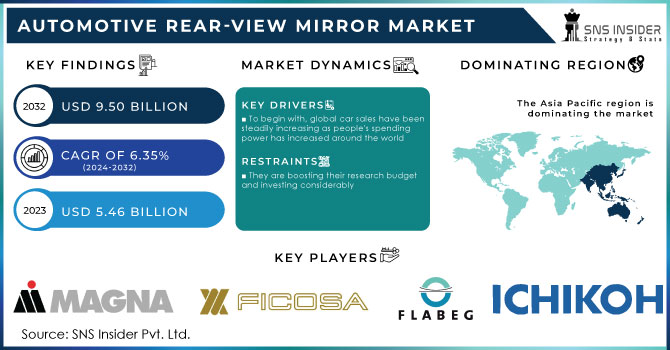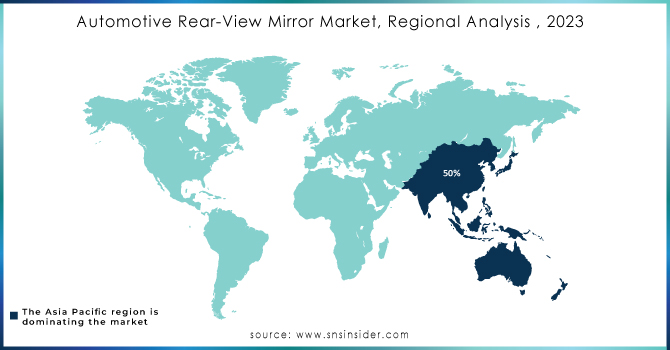Automotive Rear-View Mirror Market Size & Overview:
The Automotive Rear-View Mirror Market Size was valued at USD 5.46 billion in 2023 and is expected to reach USD 9.50 billion by 2032 and grow at a CAGR of 6.35% over the forecast period 2024-2032.
An automotive rearview mirror's primary purpose is to provide the driver with a clear view of all things to the side or rear of the car. Manufacturers are focusing on novel technology for the development of modern car rearview mirrors in order to ensure safety. The refinement of the performance of automotive side rearview mirrors, particularly mirror vibration, has received less attention. Four-wheelers and two-wheelers both have rearview mirrors.
In the past, mirrors were only used to judge the distance and type of vehicle approaching the car. However, factors such as the assault of vehicle headlight beams and the development of smart mirrors to view smaller impediments that go unobserved near the vehicle have evolved through time. The rearview mirror technology essentially covers critical components such as collecting data from the rearview camera and projecting it onto the rearview mirror screen, as well as converting the rearview mirror between a traditional mirror and a digital screen.

Get More Information on Automotive Rear-View Mirror Market - Request Sample Report
MARKET DYNAMICS:
KEY DRIVERS:
-
To begin with, global car sales have been steadily increasing as people's spending power has increased around the world
-
As vehicle movement has risen, the safety elements employed in automobiles have shifted dramatically
-
Automobile manufacturers must contend with fierce rivalry in the automotive industry, they offer cutting-edge technological features at competitive costs
RESTRAINTS:
-
They are boosting their research budget and investing considerably
-
Market growth is being hampered by a rising trend for advanced AI camera rather than mirrors
OPPORTUNITIES:
-
During the forecast period, rules and laws pertaining to car rearview mirrors are expected to boost demand for the automotive rearview mirror market
-
Several manufacturers are encouraged to introduce smart mirrors in vehicles to offer better visual clarity
CHALLENGES:
-
Vehicle buyers are increasingly concerned about the safety of passengers and vehicles
-
Smart mirrors, which raise car costs, could pose a risk to the automotive rearview mirror market's growth
IMPACT OF COVID-19:
The COVID-19 epidemic has had a negative influence on passenger and commercial vehicle sales, lowering demand. Europe continues to dominate market growth, a pattern that is projected to continue in the coming years; however, due to a recent drop in automobile sales in the region, the adoption rate has fallen. Due to economic stimulus packages and municipal constraints, the regional market is projected to see a mixed recovery cycle. Due to the COVID-19 epidemic, countries around the world have suffered a setback, significantly harming vehicle production. Following the initial lockdowns in March 2020, supply chain issues occurred, with some production facilities grinding to a halt. However, beginning in 2022, the automotive industry is predicted to rebound.
MARKET SEGMENTATION:
By Mounting Position:
-
Door Mounted
-
Body Mounted
By Features:
-
Auto-dimming
-
Automatic Folding
-
Heating Function
-
Blind Spot Detection
-
Power Control
-
Others
By Product Type:
-
Smart Rear-view Mirror
-
Conventional Rear-view Mirror
By Vehicle Type:
-
Passenger car (PC)
-
Heavy commercial vehicle (HCV)
REGIONAL ANALYSIS:
In 2020, Asia Pacific had the greatest revenue share of almost 50%, and this dominance is expected to continue throughout the forecast period. Due to rising car production in India, China, and Japan. In 2020, the area produced more than half of all vehicles produced worldwide. Furthermore, by 2030, the regional market is predicted to develop due to an increase in demand for luxury automobiles in India, as well as the availability of new purchases and replacements of automotive parts.

Get Customized Report as per your Business Requirement - Request For Customized Report
REGIONAL COVERAGE:
-
North America
-
The USA
-
Canada
-
Mexico
-
-
Europe
-
Germany
-
The UK
-
France
-
Italy
-
Spain
-
The Netherlands
-
Rest of Europe
-
-
Asia-Pacific
-
Japan
-
south Korea
-
China
-
India
-
Australia
-
Rest of Asia-Pacific
-
-
The Middle East & Africa
-
Israel
-
UAE
-
South Africa
-
Rest of Middle East & Africa
-
-
Latin America
-
Brazil
-
Argentina
-
Rest of Latin America
-
KEY PLAYERS:
Major Players Included in this market report are FLABEG Holding GmbH (Germany), Magna International Inc. (Canada), Ficosa International S.A. (Spain), Ichikoh Industries, Ltd. (Japan), Gentex Corporation (US), SL Corporation (South Korea), and Burco Inc. are the leading participants in the vehicle rearview mirror market (U.S.). Among the companies involved are Valeo SA (France), Honda Lock Manufacturing (Japan), Lumax Automotive Systems Ltd (India), and Murakami Corporation (Japan).
| Report Attributes | Details |
|---|---|
| Market Size in 2023 | US$ 5.46 Billion |
| Market Size by 2032 | US$ 9.50 Billion |
| CAGR | CAGR of 6.35% From 2024 to 2032 |
| Base Year | 2023 |
| Forecast Period | 2024-2032 |
| Historical Data | 2020-2022 |
| Report Scope & Coverage | Market Size, Segments Analysis, Competitive Landscape, Regional Analysis, DROC & SWOT Analysis, Forecast Outlook |
| Key Segments | • by Mounting Position (Door Mounted, Body Mounted) • by Features (Auto-dimming, Automatic Folding, Heating Function, Blind Spot Detection, Power Control, Others) • by Product Type (Smart Rear-view Mirror, Conventional Rear-view Mirror) • by Vehicle Type (Passenger car (PC), Heavy commercial vehicle (HCV), Light commercial vehicle (LCV)) |
| Regional Analysis/Coverage | North America (USA, Canada, Mexico), Europe (Germany, UK, France, Italy, Spain, Netherlands, Rest of Europe), Asia-Pacific (Japan, South Korea, China, India, Australia, Rest of Asia-Pacific), The Middle East & Africa (Israel, UAE, South Africa, Rest of Middle East & Africa), Latin America (Brazil, Argentina, Rest of Latin America) |
| Company Profiles | FLABEG Holding GmbH (Germany), Magna International Inc. (Canada), Ficosa International S.A. (Spain), Ichikoh Industries, Ltd. (Japan), Gentex Corporation (US), SL Corporation (South Korea), and Burco Inc. are the leading participants in the vehicle rearview mirror market (U.S.). Among the companies involved are Valeo SA (France), Honda Lock Manufacturing (Japan), Lumax Automotive Systems Ltd (India), and Murakami Corporation (Japan). |
| Key Drivers | • To begin with, global car sales have been steadily increasing as people's spending power has increased around the world. • As vehicle movement has risen, the safety elements employed in automobiles have shifted dramatically. |
| RESTRAINTS | • They are boosting their research budget and investing considerably. • Market growth is being hampered by a rising trend for advanced cameras rather than mirrors. |

